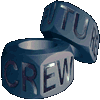

 The picture shows you, although it is more cool than many others, the lamest
part of the best demo ever - Second Reality. I think there is no single
person on earth who was not damn impressed by this production back in '93 or
is not impressed today, when watching it for the first time.
The picture shows you, although it is more cool than many others, the lamest
part of the best demo ever - Second Reality. I think there is no single
person on earth who was not damn impressed by this production back in '93 or
is not impressed today, when watching it for the first time.
This demo is not beaten in design, coolness and quality of code, and I have no idea why nobody is able to make something better...
Anyway after pascal and me tended to become part of the scene this demo convinced us that we were on the right track and pascal started heavily coding. During late '93 he had some nice vector routines with textures and transparency and he starting "research" on gouroud and phung shading.
![]() While pascal mainly stayed in his editor (the good ide of borland c 3.1) I
was mainly looking at the textmode of fast tracker 1. The picture on the left
side is only meant symbolically, as I'm not able to make a decent screen shot
from FT1. If you don't like you ears anymore and wan't them to fall of your
head, just click yourself into Audiotorium
93 and grab some old stuff from there.
While pascal mainly stayed in his editor (the good ide of borland c 3.1) I
was mainly looking at the textmode of fast tracker 1. The picture on the left
side is only meant symbolically, as I'm not able to make a decent screen shot
from FT1. If you don't like you ears anymore and wan't them to fall of your
head, just click yourself into Audiotorium
93 and grab some old stuff from there.
As I purchased my first sound card in early 94 I had no way of sampling
sounds for my first tracking experiences. So I used to rip some samples from
other modules, and as I mostly had mods containing ST01 samples my modules
used all the well known Sound Tracker samples. My connection to the global
village was a 1200 baud modem which my friend machack gave me. Leeching
modules was painfully slow and I did not grep too many. But I think
the quality or dullness of samples doesn't matter that much when you start
tracking, because there's so much more explore before. I remember
trying to find out how the pattern/position system in modules work. I
think I needed about three weeks to find out. And to learn which effect is
able to produce which result also needs some hours of playing around with the
values. As I knew no one I could ask some questions back in the old days I
had to teach myself.
1993 revolutionized the game industry. By then 3D games mostly featured
boring flat shading polygon worlds (like red baron or various other flight
simulators) or they had this pseudo 3D look (isometric games - well they had
in fact nothing of 3D just some cleverly drawn sprites).
Doom was just completly different.
Of course we all knew Wolfenstein, but it only consited of some boring walls
- no floor or ceiling. It did not look too realistic. Doom featured real fast
realistic 3D dungeons with high quality textures and well drawn sprites,
combined with good sound and light effects. This game fascinated everybody
(except people who don't like shooting games at all), and "it showed us
the way".
Rapidly various clones of the ray casting technique were released, but I think none of them was half as good as doom. What made doom powerful and superiour wasn't only the good graphics, but the well designed playability. Even when frame rates drop, you can have control over the action and the movements are traced very good from keyboard or mouse input. This is what all other games till duke lacked of. And it is no fun to play a shooter, when the keyboard routines suck !